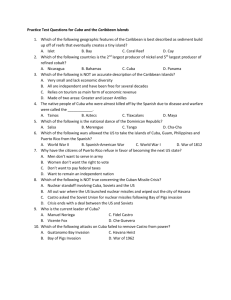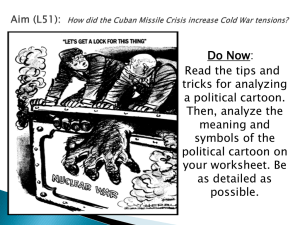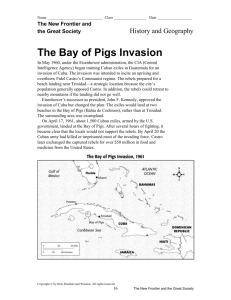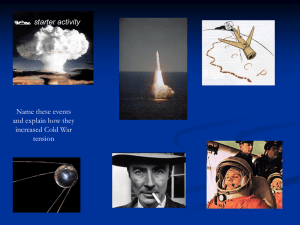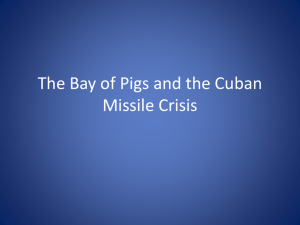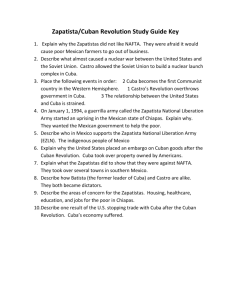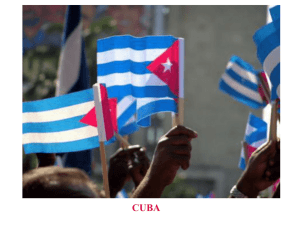(The Bay of Pigs Invasion).
advertisement
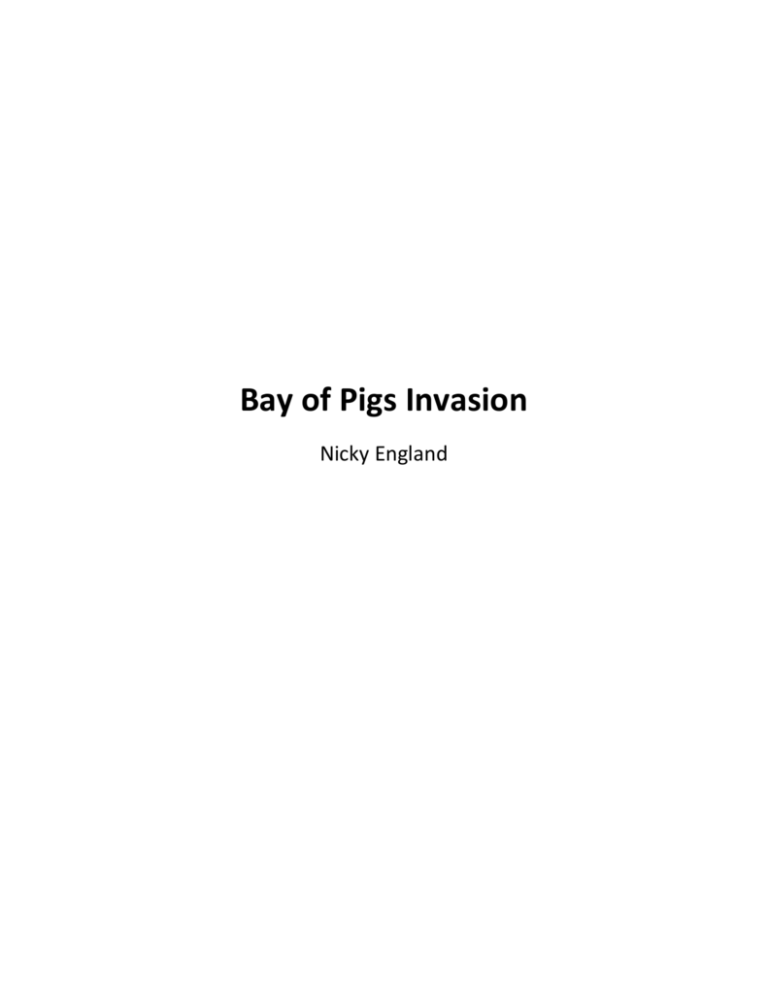
Bay of Pigs Invasion Nicky England Cuba in the 1950s had two different types of people who lived different lifestyles. There were the wealthy who enjoyed grand homes and the poor who wished for more. The wealthy did not feel that the government of Fulgencio Bautista was repressive. The poor looked to Fidel Castro to help them. The wealthy ate at the high-class cabarets and night clubs. These were also popular places for American tourists. The poor worked at the restaurants. But not everything was bad for the poor. They had their music, dance, and food which were all a blend of Spanish and African influences which reflect where they came from. A majority of them were Catholic which was brought to Cuba by the Spaniards. There are also cults that are based on practices brought by slaves from Africa. Many Cubans loved dancing especially salsa which originated in their country. Music reflected European and African sounds all blended to make a unique Cuban sound (Cuba). All these things came together at their carnivals with the largest being those in Santiago de Cuba where thousands of people enjoy the noisy, colorful, lavish musical parade of floats. The United States was at first willing to maintain civil relations with Cuba. As Fidel Castro became increasingly communist the United States government changed its mind. Because the United States wouldn’t support a communist regime, the two countries broke diplomatic ties. Shortly after, an embargo was imposed on Cuban goods. Eisenhower began the plan for the Bay of Pigs invasion. The planning actually began before diplomatic relations were broken with Cuba. Eisenhower completed so much of the planning of the Bay of Pigs Invasion that by the time President Kennedy was inaugurated virtually the only thing left to do was give the “go ahead” to commence the operation. One of the contributing reasons that America decided to take action against Cuba had to with oil. Cuba was trading sugar for Russian oil. They wanted to refine this oil in the American refineries located in Cuba. When the companies refused, Castro nationalized the refineries (Ogonowski). The Bay of Pigs was a humiliating defeat for the United States. America did not want to admit its involvement in the attack making for a bad situation for many political figures. The attack originally had to be kept a secret because the United States was still on amicable terms with Cuba when planning began. Cuban exiles from Guatemala were trained and equipped to invade. The hope was that the Cuban locals would support the rebellion. They disguised the planes to look like Cuban defectors were responsible for the attack. There were too many gaps in the cover story and the press got suspicious. An United Nations ambassador tried to keep up the cover story and even presented “official photographs.” Despite all efforts to make it look like America was not involved, the press soon uncovered the real story. There were complications in the landings. Some boats got stuck on the coral reefs which postponed the landings. When the plan started to fail, Kennedy would not directly involve the United States Air Force to support the rebels (The Bay of Pigs Invasion: Wars and Battles, April 14-19. 1961). The exiles were captured and almost all were sentenced to 30 years in prison. The total number of people captured was 1,197. Over 200 people were killed in the attack. Many political leaders were disgraced. The United States traded $53 million in food and medical supplies for the prisoners (The Bay of Pigs Invasion: Wars and Battles, April 14-19. 1961). The attack further strained relations between the United States and Cuba and contributed to the Cuban Missile Crisis. Because Cuba disliked America, they accepted Russia’s request to place missiles trained on the United States in Cuba. Dwight D. Eisenhower was the 34th president of the United States. During his presidency he ended the war in Korea. He also dealt with the Cold War and tried to create amiable relations with Russia while still fighting communism. However, his plan to be peaceful with Russia failed and so he began to plan the Bay of Pigs attack. He saw Cuba as a potential threat because with Castro in power communism was an even more prevalent threat (Biography: Dwight David Eisenhower ). Fidel Castro is the leader of Cuba. He came to power in 1959 after trying several times to overthrow the Batista regime using guerilla tactics. When Castro became leader, many Cubans fled the country to escape from living in a communist government. When the United States attacked Cuba in the Bay of Pigs incident, Cuba defeated the Cuban invaders. This led to lasting friction between the two governments that continues today. The Bay of Pigs invasion had several long term effects. The most significant one is that Cuba is still a communist country. The reason for the invasion was to remove Castro from power and to glorify Americans and the returning Cubans. The invasion actually caused the opposite to happen. Castro’s popularity as a communist leader increased. He continues to rule Cuba to this day and America only succeeded in becoming Cuba’s enemy. Cuba then became a close partner with Russia which led to the Cuban Missile Crisis. The second long-term effect is an economic one. When the United States instituted an embargo on Cuban goods, they lost a lot of revenue. “It is estimated that, if the embargo were lifted, the United States would gain $1 billion of business in the first year” (The Bay of Pigs Invasion). Bibliography Biography: Dwight David Eisenhower . 2000. 31 January 2010 <http://www.dwightdeisenhower.com/biodde.html>. Broadcasting, Oregon Public. Cold War I: Bay of Pigs. 2001. 2010 31 January <http://www.opb.org/education/coldwar/bayofpigs/timeline/1962.html>. Caro, Adolfo Rivero. Cuba: The Unnecessary Revolution. 2010 31 January <http://www.neoliberalismo.com/unnecesary.htm>. Countries and Their Culture. 31 January 2010 <http://www.everyculture.com/Cr-Ga/Cuba.html>. Cuba. 1996-2009. National Geographic Society. 31 January 2010 <http://worldmusic.nationalgeographic.com/view/page.basic/country/content.country/cuba_11/en_US >. Cuba Before Fidel Castro. 31 January 2010 <http://www.fiu.edu/~fcf/cubaprecastro21698.html>. Fidel Castro. 2010 31 January <http://www.u-s-history.com/pages/h1766.html>. Ogonowski, Julie. Background on the Conflict. 1997. 31 January 2010 <http://www.earlham.edu/~pols/ps17971/weissdo/background1.html>. Sierra, J.A. HistoryofCuba.com. 31 January 2010 <http://www.historyofcuba.com/history/havana/Lansky.htm>. The Bay of Pigs Invasion. 1997- 2009. 31 January 2010 <http://www.cyberessays.com>. The Bay of Pigs Invasion: Wars and Battles, April 14-19. 1961. 11 November 2009. 31 January 2010 <http://www.surveillance-video.com/pigs-nov-2009.html>. The Cuban Experience. 1998. 31 January 2010 <http://library.thinkquest.org/18355/fidel_castro.html>.
